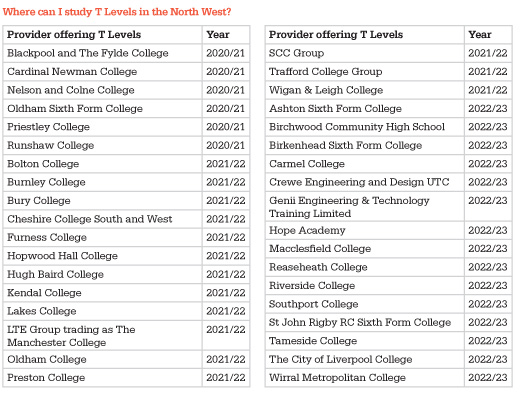T-levels – The next level qualification

by Hannah Fowler
After years of demanding study and hard work, students can finally celebrate finishing their GCSEs. But what level next? Students in England have to stay in education until they are 18, either going on to college, sixth form, an apprenticeship or studying part-time while volunteering or working.
From A levels, vocational qualifications, traineeships to apprenticeships, the educational landscape can be hard to navigate. And from this September, a new post GCSE option is being added to the mix – T Levels.
Whilst this brings exciting opportunities for future careers, it can also be daunting for students and their parents who are overwhelmed with the many options available. For those confused on the best path to take, here is our guide to T Levels, and a reminder of the other routes available after GCSEs.
What are T Levels?
T Levels (Technical Levels) are new courses coming in September 2020 for 16-19 year olds who have completed their GCSEs. The two-year courses, equivalent to three A levels, have been developed in collaboration with employers and businesses so that the content meets the needs of industry and prepares students for the world of work.
T Levels will offer students a mixture of classroom learning and ‘on-the-job’ experience during an industry placement. The new qualification has been launched to provide the knowledge and experience needed to open the door into skilled employment, further study or a higher apprenticeship.
Students will be able to take a T Level in 25 subject areas when they are fully rolled out by 2023, such as accounting, catering, hair and beauty, healthcare science and legal. But the first three T Levels launching in 2020 include:
• Design, surveying and planning for construction
• Digital production, design and development
• Education and childcare
Followed by these subject areas in 2021:
• Building services engineering for construction
• Digital business services
• Digital support and services
• Health
• Healthcare science
• Onsite construction
• Science
Schools, colleges and training providers can set their own entry requirements for each T Level, but they commonly ask for five GCSEs at grades 4-9.
How will T Levels be taught?
T Level courses are made up of the following elements:
1. A technical qualification which will include core theory, concepts and skills in a chosen industry area, and specialist skills and knowledge for an occupation or career
2. An industry placement with an employer for at least 45 days (315 hours)
3. A minimum standard in maths and English (if students have not already achieved this)
Unlike apprenticeships, where students spend most of their time in the workplace, students on T Levels will be classroom based for 80 per cent of the time and on an extended industry placement for the remaining 20 per cent. There is no legal requirement or expectation that students will be paid while on the industry placement, it’s designed to give students a broader idea of what it’s like to work in a certain sector with the opportunity to specialise later. If a student knows what occupation they wish to pursue and wants to earn a wage while learning, they may be better suited on an apprenticeship.
What can I do after T Levels?
Students who complete their T Level will receive an overall grade of pass, merit, distinction or distinction*. The nationally recognised T Level certificate will include an overall grade as well as confirmation that the student has met the minimum requirement for maths and English and completed the industry placement. If a student leaves a T Level early, or does not pass all of the elements, they will receive a statement of achievement confirming which requirements have been met.
After completing a T Level, students can find employment in a skilled occupation in their chosen career or continue their studies with a higher apprenticeship or degree at university. To help students get into higher education, T Level qualifications can be converted into UCAS points, in the same way as A levels.
WHY CHOOSE A T LEVEL?
BACKED BY INDUSTRY: T Levels have been designed with leading businesses and employers, such as Fujitsu, Morgan Sindall and Rolls Royce, to give students the knowledge and skills to succeed in the competitive job market.
VALUABLE WORK EXPERIENCE: During the industry placement, students can make connections, gain a valuable reference for their CV or UCAS application, and improve a range of technical and personal skills that employers value.
STAND OUT AND GET AHEAD: Students will gain a real insight into the industry they are training to enter. This is a fantastic head start when applying for job roles after completing a T Level, or choosing which higher education option is right for them.
To find a T Level near you, visit tlevels.gov.uk/students
What other post-GCSE options are available?
A levels – A levels (Advanced Levels) are a subject-based qualification that can lead to university, further study, training or work. Students normally study three or more A levels over two years. Studying a selection of A levels can be a good option for students who are unsure what career or job they want to go into or wish to progress to university (although many universities will accept vocational qualifications such as NVQs, BTECs and the new T Levels).
Apprenticeships – An apprenticeship is a work-based training opportunity that let’s young people earn money while they train in a specific industry, such as motor vehicle or health and social care. Apprentices will spend 80 per cent of their time in employment and the remaining 20 per cent in ‘off the job training’, often at a college, university or with a training provider.
Apprenticeships are available at companies large and small, and can last anything from one to six years to complete, depending on the type and level of apprenticeship chosen.
Vocational study programmes – Many school sixth forms and further education colleges offer vocational qualifications which are designed to teach students in a practical way about a particular job area, such as construction, engineering, hairdressing and retail. They are a good option for those who have a clear idea of what type of career or trade they would like to work in. Some schools and sixth form colleges may let you mix vocational qualifications, such as BTECs with A levels.
Traineeships – A traineeship is a course that includes a work placement, and can last from 6 weeks up to 6 months. Traineeships help 16-24 year olds (or 25 year olds with a EHC plan) get ready for an apprenticeship or job if they don’t have the appropriate skills or experience. CV writing, digital skills, maths and English are all taught on a traineeship, alongside a work placement of at least 70 hours and an interview for a job if available.
If not, students will still receive an exit interview with written feedback to help them secure an apprenticeship or employment.



